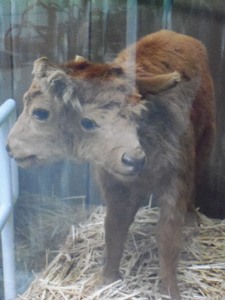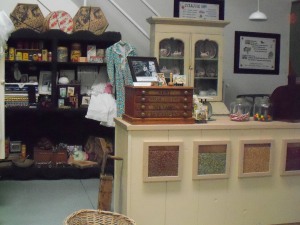This seems like a good week to write about a topic I’ve been promising for a while now: our hometown museum, The Syracuse Museum and Cultural Center. Upon moving here in July of 2009, I took notice of it just a stone’s throw from where we live. Why it took me a full year to finally stop in to investigate, I can’t say. But last July, one day when Ethan was off track from school and the museum was open, we made a visit and took a tour. Upon leaving, I thought that it might be fun to volunteer some time here–something I have plenty of now–and I decided to think it over. I got to the car and decided, why wait? So I headed back, gave the folks there that day my name and phone number and I became a volunteer. I’ve been going in on a regular basis most Wednesdays from 1:00-3:00.
Most of the volunteer staff are older retirees, like me, but when I showed up on the doorstep, apparently I brought much needed computer (the other women volunteers don’t even know how to turn on a computer) and writing skills that no one had. So I spend my time composing exhibit labels, explanatory notes, editing existing information sheets and creating new ones. I work with Bev and Phil Gooch who were there the day I first visited and they are really friendly and helpful. Bev puts a lot of the exhibits together and is clever at designing the lay-outs. She also grew up around here, so she knows just about everyone and the history of the area of Syracuse. (It’s totally gone now, but Syracuse once had a vacation spa resort on the shores of the Great Salt Lake. The old photos are intriguing.) I also have a feeling I’ll be asked to join the board of directors as well in the near future.
Anyway, enough about what I do there. Let me take you on a virtual tour of the two buildings that comprise the facility: the main changing exhibit area and the farm and out buildings complex. The main building holds donated items that belonged to families who helped settle the Syracuse area (one section–actually where our house is–being known as Starvation Flats. Must have been a tough go!) There are the usual tea sets that came out via wagon train or handcart, embroidered pillowcases, quilts, dresses, hats, gloves, musical instruments, furniture, family and local photos and Mormon religious books (a 1st edition Book of Mormon from 1830, Mormon hymnal, and other related church texts) that one would expect in a town museum that celebrates pioneer heritage. A huge stuffed bison head even hangs on one wall.
A newly built platform with small scale houses, shops, wagons, people and a train depicts what the town looked like from 1876 to 1910. There aren’t many old original buildings left; modern progress and highways have changed the appearance of Syracuse. The old pioneer wagon train road, once called Emigrant Road is now paved and sports a new name, Bluff Road. It runs about 1/4 mile behind our house.
The second part of the tour takes visitors to the farm building and out buildings. The farm building isn’t a barn, but a single storey long metal structure that actually is the repository of the really (in my estimation) interesting stuff! Farming was a huge part of life here in the late 1800s and first half of the 20th century. Syracuse (once irrigation wells were drilled) was known for its fruit and vegetable industry. Raw and canned produce were shipped via train (once the country was joined by the
railway in the late 1860s) to all parts of the nation. The sugar beet crop was important as were onions, peaches, cherries and plums. Onions are the only big crop left that is shipped out for sale in national markets.
Among the farm and pioneer life displays are horse-drawn plows, seed drills, tillers–all basic iron components (like wheels and seat) and must have been a rough, hot ride. Also there to see is a dry goods store, a blacksmith set-up, and areas that cover the pea and sugar beet industry. The museum also has a mock farm kitchen tableau to show how challenging life was for the lady of the house.
There are several educational areas for the kids, including a chicken coop where kids can gather wooden “eggs,” a pig sty with an artificial sow and her pigletts, and a working replica of a cow that has the capability of being “milked” (water comes out) so kids can see what’s it’s like to hand milk a cow.
The museum offers the expected barbed-wire collection; this seems to be mandatory, most town museums have a barbed-wire display. The photo below is only two of the panels. There are over 600 different configurations of barbed wire! And we have something unique to the Syracuse Museum: a real stuffed two-headed calf. Apparently one was born in the early 1990s on a town farm, didn’t survive very long and was taken to a taxidermist and then donated to the museum. I know it’s sort of a queezy thought, but our museum is well known for it and visitors always ask to see it.
You know you’re in farm country when you see a collection of pitch forks hung on the wall
or washing machines from the good old days.
Out buildings in the complex include the town’s one-room barber shop and one of the first log cabins in the area (actually moved from nearby Kaysville to the Syracuse Museum property. It has one room on the ground floor and a second floor sleeping area under the eaves. The original Wilcox family who built it raised 9 children in it. Talk about tight quarters!
Here are some other photos from our tour of the museum:
So that’s a taste of Syracuse’s history and museum. It’s nice that the local folks cared enough to gather and donate all these items from the past and maintain them. There’s a lot of grant writing involved (thank heavens I’m not involved in that!) and the mayor and town council support the museum’s efforts. In fact, a local family with deep roots in Syracuse is funding an essay contest this spring for area students in three general age groups. The students will have several choices as to topics dealing with pathfinding (the museum’s theme for 2011) or historical subjects and there’s nice prize money attached to winning 1st, 2nd, or 3rd place awards. One of the perks of retirement is that I no longer had to read and grade student essays…guess who will be on the committee to read and judge the contest essays?! I’m sure there will be a blog posting or two about that adventure. Thanks for stopping by the museum. Care to sign the visitors’ book?













Nice tour.. the “simpler” life. Can you believe an artist actually created Bessie the milking calf.. I have now found my calling! However, found myself a little prickly looking at the two headed calf… sad natural phenom.